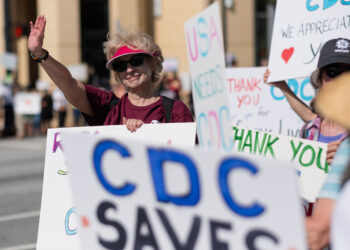
- Respiratory illnesses like influenza, COVID-19, and RSV are surging across the United States, according to CDC data.
- Norovirus, the notorious stomach bug associated with cruise ship outbreaks, has also been pegged to a large number of cases in recent weeks.
- Older adults and young children are the two most high risk groups for severe respiratory illness, which may require hospitalization.
Flu season might soon be dubbed “sick season” as a cocktail of respiratory viruses, including influenza, COVID-19, and respiratory syncytial virus (RSV), surges across the United States.
This, coupled with an outbreak of a highly contagious stomach bug known as norovirus, may make it seem like almost everyone you know is getting sick.
The
“It’s roaring along, that’s for sure. Influenza has been increasing over the last month and has really surged upwards,” William Schaffner, MD, a professor of preventive medicine and infectious diseases in the Department of Health Policy at Vanderbilt University Medical Center in Nashville, told Healthline.
Meanwhile, norovirus, known by a less flattering name, “winter vomiting disease,” has caused an unusually high number of outbreaks. During the first week of December, state health departments reported
Yet, despite the confluence of viral activity, this year appears to generally be in line with prior years, excluding the COVID-19 pandemic.
“It’s really not too much worse than other years,” Dean Winslow, MD, a professor of Medicine and infectious disease expert at Stanford Medicine, told Healthline.
Flu season has been a regular part of the calendar season, but that all changed with the COVID-19 pandemic in 2020. Since then, the COVID-19 virus has continued on in the background, regularly flaring up, alongside flu, but not on the exact same timeline.
“It’s now part of our viral ecology, like these other viruses,” said Schaffner.
However, unlike flu and RSV, COVID-19 has historically had two yearly peaks.
“There’s a smaller one in the summer and then a somewhat larger one during the winter season. The others, influenza, RSV, and the many other common cold viruses, they increase during the winter season,” explained Schaffner.
Emergency department visits for COVID-19 are low compared to both flu and RSV so far this year, but they are increasing,
Still, Judith O’Donnell, MD, section chief of Infectious Diseases at Penn Presbyterian Medical Center and a professor of infectious diseases at the University of Pennsylvania, described the respiratory virus trends as “very typical.”
RSV, which leads to hospitalizations for an estimated up to
“The thing we really worry about is RSV in young children, less than six months of age. They can actually get very, very sick and develop a condition called bronchiolitis, infection and inflammation of the small airways,” said Winslow.
In addition to respiratory illness, a novel strain of the stomach bug norovirus, known as GII.17[P17], has been linked to a large number of outbreaks in the past several weeks.
O’Donnell explained that norovirus appears more prevalent this winter compared to prior years.
Samples from
“In contrast to respiratory viruses, this is an intestinal virus that involves your stomach and your intestines and colon. It’s extraordinarily transmissible from person to person and can survive on environmental surfaces,” explained Schaffner.
The virus spreads easily in enclosed spaces and close quarters and has frequently been linked to outbreaks on cruise ships. In fact, the cruise industry had one of its worst years on record for norovirus outbreaks,
“Other similar populations include nursing homes, senior citizen centers, schools, and prisons. So, any of these enclosed or semi-enclosed populations can be the locus for a big outbreak,” said Schaffner.
To protect yourself from the myriad viruses floating around right now, take a multi-pronged approach.
For both COVID-19 and flu, getting vaccinated is the most effective way to prevent infection or reduce the severity of symptoms if you do get sick. While there is a vaccine for RSV, it is only
Additionally, your doctor may prescribe antiviral medications if you develop COVID-19 or flu. Paxlovid is prescribed for the former, while Tamiflu (oseltamivir) is prescribed for the latter.
There are also good habits to work on that will help in preventing infection of both respiratory viruses and norovirus.
“Wash hands frequently. Consider wearing a well-fitting mask if you must be out and have significant concerns about getting sick. Masking remains highly effective,” said O’Donnell. Avoiding large gatherings and staying home from work or school when sick is also important to limit the spread.
Sanitizing gels, sprays, and foams, can also help to inhibit the spread of respiratory viruses, but they are far less effective against norovirus.
“Most of the hand sanitizers are alcohol-based. But norovirus is a very hearty organism in terms of persisting in the environment, so the best thing from an individual perspective is very thorough handwashing,” said Winslow.
Respiratory illnesses caused by influenza, COVID-19, and RSV are surging across the U.S. Despite the high number of current cases, the statistics appear generally in line with years prior.
A novel strain of the stomach bug norovirus known as GII.17[P17] has also been linked to a high number of outbreaks in recent weeks. The virus is highly contagious and can cause severe diarrhea and vomiting.
To limit your risk of respiratory illness, vaccinations for both COVID-19 and influenza are recommended. Frequent handwashing and avoiding social gatherings during peak season are also highly recommended to avoid getting sick.
Source link : https://www.healthline.com/health-news/flu-season-rsv-norovirus-how-to-protect-yourself
Author :
Publish date : 2025-01-13 16:37:05
Copyright for syndicated content belongs to the linked Source.














